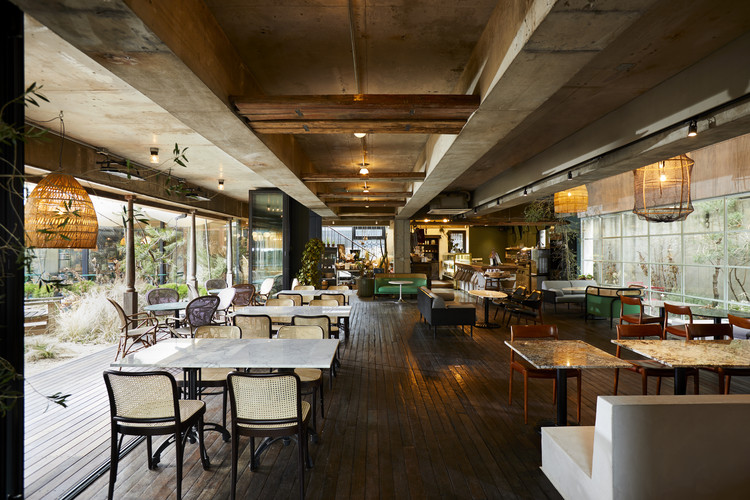National Archives Preservation Facility May + Russell Architects
2017-06-19 17:00
架构师提供的文本描述。国家档案保存设施(NAPF)是一个拥有超过1,500万份文件和视听记录的存储、管理和保存设施,其设计理念以“您的故事,我们的历史”为基础。建筑设计对话的目的是表达其作为国家集体记忆的象征守护者的功能,代表“档案”的主要功能和“档案工作者的空间”。主要的概念是表达时间的推移-无论是过去还是未来。
Text description provided by the architects. The National Archives Preservation Facility (NAPF) is a facility for over 15 million paper and audio visual records storage, management and preservation with the underpinning design philosophy of “Your story, our history”. The architectural dialogue of the design is to express its function as the symbolic keeper of the nation’s collective memory, and represent the primary functions of ‘archives’ and a ‘space for archivists’. The predominant concept is to express the passage of time – both the past and the future.
它的形式和规模与其在工业区内的位置有关,也与档案设施的国际架构有关。虽然不是正式的街道地址,但NAPF有一个主要的高地,毗邻一条连接堪培拉市和主要增长城镇中心Gungahlin的重要通勤道路。作为未来轻轨系统的主要运输走廊和通道,每天的通勤者都会在黎明和黄昏的极端时刻通过该设施。立面由预制混凝土面板组成,这些面板是用来突出白天不同时间投射的太阳角和阴影的。这些面板的北边和南边分别用黄昏和黎明色的鳍发出,这有趣地吸引了上班族来思考时间的流逝。
Its form and scale relates to its location within an industrial area as well as relating to an international architecture for archive facilities. Although not its formal street address, the NAPF has a dominating elevation adjacent to a key commuter road linking Canberra city with Gungahlin, a major growth town centre. As a main transport corridor and passageway for the future light rail system, the daily grind of commuters will pass the facility at the extreme ends of the day – dawn and dusk. The façade is comprised of precast concrete panels, which are articulated to accentuate the sun angles and shadows cast at various times throughout the day. The North and South edges of these panels are respectively pronounced with dusk and dawn coloured fins which playfully engage commuters to contemplate the passage of time.
预制混凝土形式容纳了设施的档案功能,要求没有窗户,并为最大限度地提高热效率而建造。它通过描绘一个风化和侵蚀的块体来描述我们的过去和澳大利亚的景观,唤起一个永恒的花岗岩露头,捕捉一个升起或落下的太阳。箱体形式和统一的结构网格为移动存储紧凑单元提供了最有效的地板,从外部驱动了出口楼梯的规划,因此以黎明和黄昏的颜色庆祝。
The precast concrete form houses the archival function of the facility, required to be devoid of windows and constructed to maximise thermal efficiency. It references our past and the Australian landscape by depicting a weathered and eroded mass, evoking a timeless granite outcrop catching a rising or setting sun. The box form and unitised structural grid provides the most efficient floorplate for mobile storage compactus units, which drove the planning of the egress stairs externally, and hence celebrated with the colours of dawn and dusk.
与之形成鲜明对比的是,档案工作者的空间代表着当今和我们的未来。轻巧的金属包层结构是一个平滑的,机器样的盒子,有规则的线条和模块化的开口.把这两个截然不同的空间连接起来的中央循环脊柱叫做档案街。一个充满光线的中庭空间,为在截然不同的环境之间过渡提供视觉上的浮雕,100米长的地方覆盖着泥土色调的粘土面板,在一个短暂的图形中描绘了运动和时间的推移,走向数字化记录的未来。档案行是为档案工作者之间的偶遇与合作提供空间,为他们在为子孙后代保存我们的历史所扮演的重要角色带来骄傲和尊重。
In stark contrast, the space for archivists is representative of the present day and our future. The lightweight, metal clad construction is a smooth, machine-like box with regular lines and modular openings. The central circulation spine which connects these two distinct spaces is called Archive Row. A light filled atrium space to provide visual relief to transition between the starkly different environments, the 100m length is clad with clay panels of earthy tones, in a transient graphic depicting movement and the passage of time towards the future of digitised records. Archive Row is to provide a space for incidental encounter and collaboration amongst archivists, to engender pride and respect for the important role they play in preserving our history for future generations.
虽然档案的未来进入了数字时代,但NAPF是一个独特的设施,它讲述了国家的历史和未来。
Although the future of archives forges into the digital age, the NAPF is a unique facility which tells the story of the nation; both the past and the future.
 举报
举报
别默默的看了,快登录帮我评论一下吧!:)
注册
登录
更多评论
相关文章
-

描边风设计中,最容易犯的8种问题分析
2018年走过了四分之一,LOGO设计趋势也清晰了LOGO设计
-

描边风设计中,最容易犯的8种问题分析
2018年走过了四分之一,LOGO设计趋势也清晰了LOGO设计
-

描边风设计中,最容易犯的8种问题分析
2018年走过了四分之一,LOGO设计趋势也清晰了LOGO设计


















































































